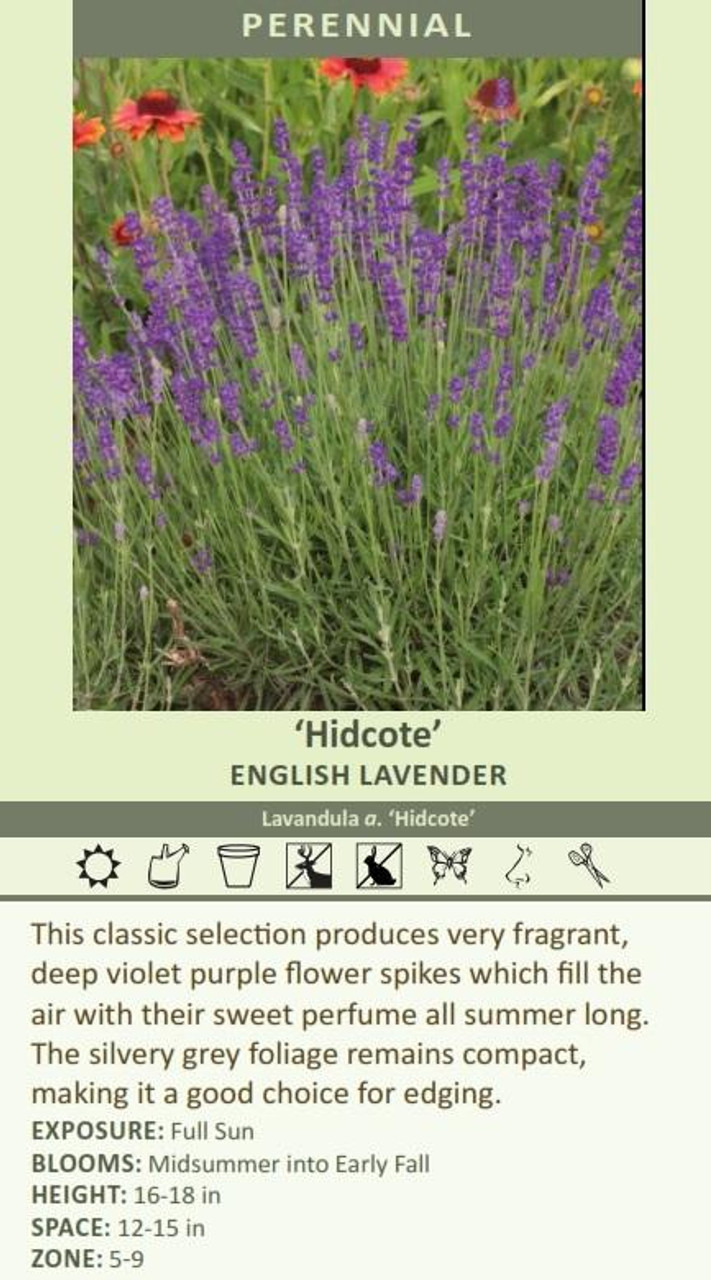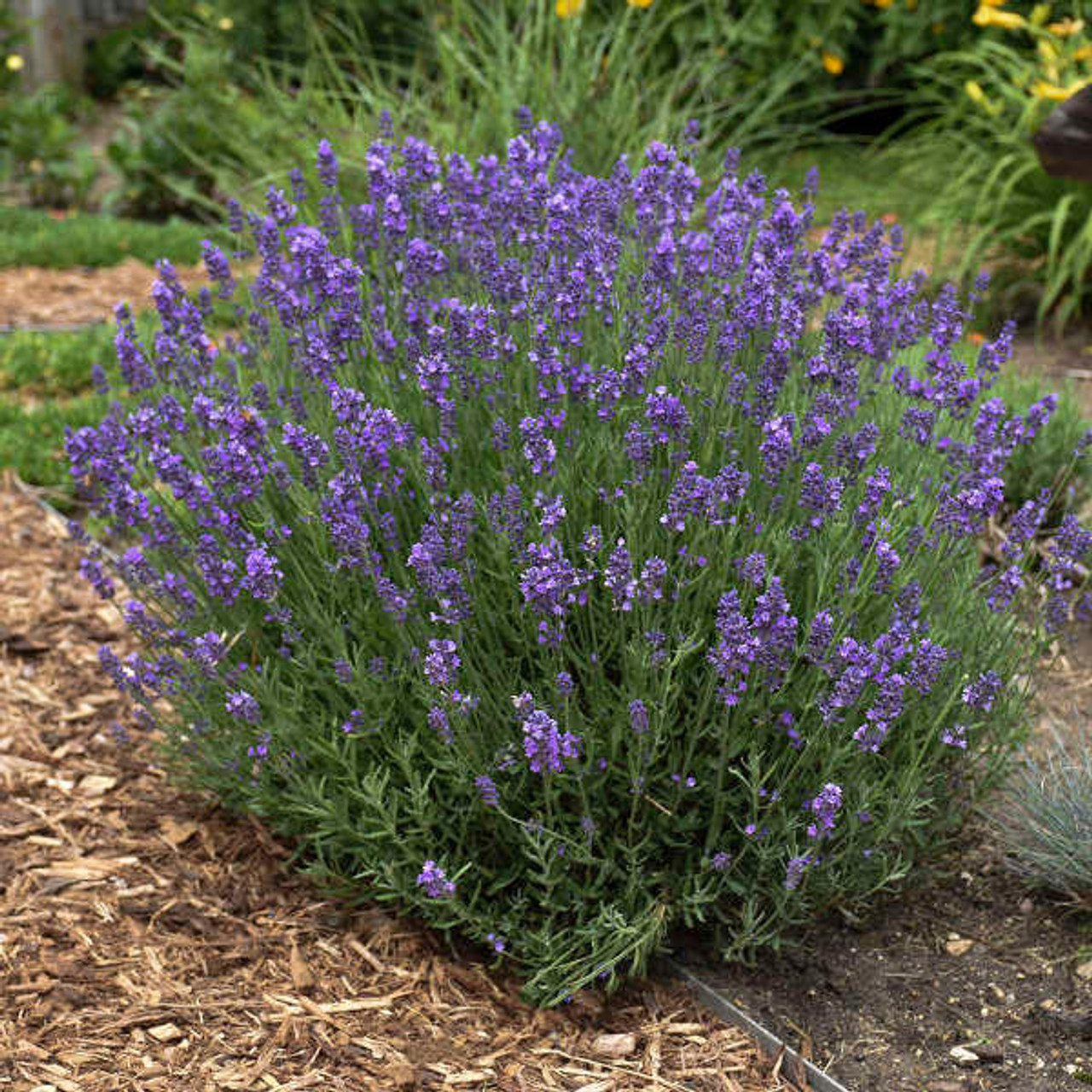Product Description
Lavandula angustifolia 'Hidcote' (20)ct Flat
Common Name: English Lavender
Deep violet-purple flower spikes fill the air with their sweet, intoxicating fragrance all summer long. Though this cultivar has been grown for over 50 years, it remains one of the most popular today. Its compact habit and relatively short stature makes it a good choice for edging. It is very similar to 'Munstead.'
Lavender must be grown in full sun to be able to produce flowers, so do not hesitate to plant them in those hot, dry areas where nothing else seems to grow. They will actually grow better in poor, gravelly soil than in rich humus; don't be tempted to enrich the soil when you plant it. Sharp drainage, especially in winter, is essential for preventing crown rot. Other than that, Lavender is known to have few problems with pests and diseases. Shearing back the evergreen foliage in early spring will rejuvenate plants and stimulate new growth.
Lavender has been grown for centuries for its intensely fragrant flowers and beautiful appearance. It is a staple item of every sunny garden, and its dried flowers are widely used in potpourris and arrangements.
Royal Horticultural Society's Award of Garden Merit 2001
Royal Horticultural Society's Award of Garden Merit 1993
Height: 16-18 Inches
Spread: 12-15 Inches
Hardiness Zones: 5,6,7,8,9
Flower Color: Purple shades
Foliage Color: Silver/grey shades
Full Sun (> 6 hrs. Direct Sun)
Low Water Needs
Poor Soil Quality
Bloomtime: Midsummer - Early Fall
Attracts Butterflies
Bee Friendly
Deer and Rabbit Resistant
Seasonal Interest: Dried Seed Heads
Evergreen
Growth Rate: Medium
Border Plant, Container, Cut Flower, Cut Foliage, Dried Flower, Drought Tolerant, Edging, Fragrant Flowers, Fragrant Foliage, Mass Planting
Lavandula angustifolia 'Hidcote' is a beloved and widely-planted cultivar of English Lavender. It is prized for its beauty, fragrance, and versatility in the garden. Here is a look at what makes it so special:
Appearance:
- Compact and neat: 'Hidcote' has a compact, bushy growth habit, typically reaching 12-24 inches tall and wide. This makes it a great choice for smaller gardens or formal plantings.
- Deep purple flowers: It produces an abundance of fragrant, deep purple-blue flowers on long, slender stems. The color is particularly rich and vibrant, making it a standout in the garden.
- Gray-green foliage: The evergreen foliage is a lovely shade of gray-green, providing a beautiful backdrop for the purple blooms and adding to the plant's overall appeal.
Growing Conditions:
- Sun lover: 'Hidcote' thrives in full sun, needing at least 6-8 hours of direct sunlight per day.
- Well-drained soil: It prefers well-drained soil and is drought-tolerant once established. Avoid overwatering, as this can lead to root rot.
- Hardiness: This cultivar is hardy in USDA zones 5-9, making it adaptable to a wide range of climates.
Uses:
- Borders and edging: Its compact size makes it perfect for edging borders or pathways.
- Herb gardens: It is a classic addition to herb gardens, where its fragrant flowers and foliage can be enjoyed.
- Containers: It can be grown in containers, adding a touch of beauty and fragrance to patios or decks.
- Cut flowers: The flowers are excellent for cutting and drying, adding a lovely scent to bouquets and arrangements.
- Lavender wands: The long stems can be used to make traditional lavender wands.
Benefits:
- Beautiful and fragrant: The combination of deep purple flowers and gray-green foliage is a visual treat, and the fragrance is simply divine.
- Attracts pollinators: The flowers are a magnet for bees and butterflies.
- Repels deer and rabbits: The strong scent of lavender is known to deter deer and rabbits.
- Drought-tolerant: Once established, it requires minimal watering, making it a good choice for water-wise gardens.
Things to keep in mind:
- Pruning: Regular pruning is essential to maintain its shape and encourage bushier growth. Prune lightly after flowering and again in early spring.
- Lifespan: Lavender plants have a limited lifespan, typically around 5-7 years. However, you can prolong their life with proper care and pruning.
Overall, Lavandula angustifolia 'Hidcote' is a beautiful and versatile plant that is sure to enhance any garden with its beauty, fragrance, and versatility. It is a classic choice that has been loved by gardeners for generations.
Other Details
The most important part of the plant is its root system. Healthy roots are the foundation of a healthy, vibrant plant. The type of plug container used is based on the specific needs of the plants. Perennials offered as bare root traditionally perform better when planted as bare root.Planted in a specialized mix, potted plants have well established root systems. Top growth stage will vary depending on the current life cycle and time of year when shipped. In Winter and early Spring dormant plants may be shipped. Dormant plants may be planted right away, even before the last frost date.
Most bare root varieties are field grown for at least one season, though Hemerocallis and Hosta are grown for two seasons. The bulk of the soil is removed during the harvesting process and the tops of most varieties are trimmed back to the crown. They are graded, packed in shredded aspen or sphagnum moss and stored in freezers until ready to be shipped.
See our Container Sizes and Bare Root Perennials pages for more information.
Plant information and care is provided in the Overview section, Plant Genus Page and general information is provided in the Planting Care & Guides. Additional questions can be asked on each Plant page.
Plant Spacing: Using the maximum mature spread or width of a plant to guide spacing, ensures space to grow to full size. To fill an area sooner, plant them closer together. Just remember, future thinning or transplanting may be needed.
Water: Keep a close eye on newly planted perennials, especially throughout the first growing year. Most early plant loss is due to too much or too little water!
























